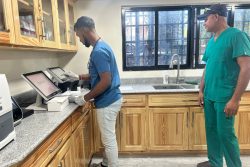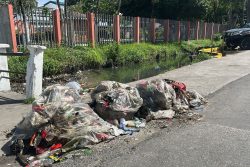KEY WEST, Florida (Reuters) – Packed with cocaine and grimly christened “coffins,” sleek jungle-built submarines are steaming their way north from Colombia through Pacific waters to deliver tons of illegal drugs headed for the US market. Skimming just below the water line, with only a glimpse of a glass-enclosed cockpit or metal tubes visible from above, the semi-submersibles are the latest shipment method used by trafficking cartels to try to elude detection by authorities.
A pilot and three or four crewmen squeeze into the cramped hulls of the craft on voyages from Colombia’s Pacific Coast up to Central America or Mexico, where their cargoes are offloaded for shipment to the United States, the US Coast Guard says. There is no bathroom or galley and the heat can be searing in the narrow space the smugglers share in the stern of the craft, just a few feet away from the throbbing diesel engines. “They call it either the coffin or the tomb,” said Rear Admiral Joseph Nimmich, the officer who commands the US Coast Guard’s Joint Interagency Task Force South.
“The intent is to be as low-profile, and to make it as difficult for us to find, as possible.”
The task force Nimmich heads, an umbrella group that includes the US military, Drug Enforcement Administration, FBI and Central Intelligence Agency, focuses on monitoring and detecting drug trafficking in the Western Hemisphere.
It estimates that some 60 to 75 of the fibreglass vessels, also known as “narco-subs” and capable of carrying upward of eight tons of cocaine when fully loaded, are built in clandestine jungle shipyards in northwest Colombia every year.
That makes the fleet big enough to handle almost all of Colombia’s annual exports of cocaine, estimated by United Nations monitors to total about 600 metric tons a year.
Nimmich spoke to Reuters in an interview last week at a navy dock in Key West, Florida where one of the vessels is on display. Fifty-nine feet long and about 12 feet wide, it was caught in the Pacific Ocean with its four-man crew and a payload of about seven tons of cocaine last September.
The “coffin” nickname for the vessels stems from the fact that some suffered catastrophic hull failures in the early stages of their development.
Nimmich said the boats, originally designed by Russian, Pakistani and Sri Lankan engineers, had since become increasingly sophisticated in their seaworthiness, propulsion systems and other features.
The smuggling runs from Colombia to Mexico or Guatemala, where the cocaine is offloaded for shipment to the United States, can take up to two weeks. But that is only because the boats slow their powerful engines to a crawl during the day, to avoid detection of their wakes.
Among other new features, the vessel lashed to the dock at the Key West Naval Air Station had an underwater exhaust cooling system to help the boat, painted light grey with speckles of blue, avoid producing a heat signature that could be spotted by infrared radar systems
“Very low technological capabilities can have a high impact on our sensor system,” Nimmich said.
Until now, the vessels appear to have been used almost exclusively to run cocaine from the Pacific side of Colombia, Nimmich said. But at least one, with a very large cargo capacity and a twin-engine power plant, had been found on the eastern side of Colombia on the Guajira Peninsula, he added.
Recent reports of building activity in the Caribbean region have not been confirmed, Nimmich added. He said intelligence pointing to construction of at least one semi-submersible, to run cocaine to Europe out of Brazil’s Amazon River Basin, could also not be confirmed, but that this would not be a surprise.









